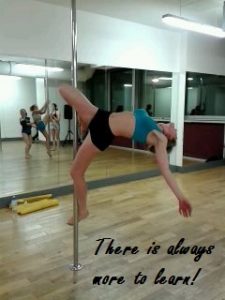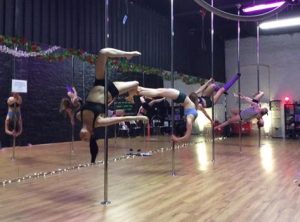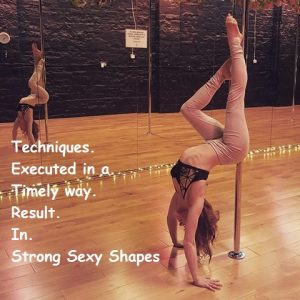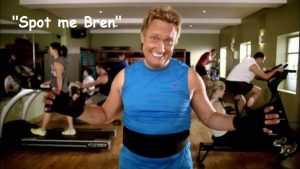Preface
If I were to commit to being an animal for the rest of my life, I think I would be a BEE! It seems like natural selection given my tendencies. Bees are natural foragers as in they collect pollen from a variety of flowers to make the best honey for the benefit of the hive and all the other bees!
 I have poled for 6 years, I have instructed for 3. I have attended workshops with some of the pioneers of our passion. I watch an infinite number of videos and read everything and anything that catches my eye because it includes the word pole, dance, human body, techniques, conditioning, strength, injury or safety.
I have poled for 6 years, I have instructed for 3. I have attended workshops with some of the pioneers of our passion. I watch an infinite number of videos and read everything and anything that catches my eye because it includes the word pole, dance, human body, techniques, conditioning, strength, injury or safety.
In my ‘off the pole’ life, I am a mom and an educationalist. I work with young people who are on their collective yet individual road to adulthood. On this note, I read and watch everything and anything related to the principles and methods of teaching and learning. Despite my formal education, I am for the most part auto-didactic, like us all really. If it interests me, I gobble it up, bite-size or whole.
So, what does all of this have to do with safe poling?
I am a forager (like the aforementioned bee). Much like, the process of learning a new trick, I stand on the shoulders of those giants who put time and energy into their journey. The information imparted here is experiential as much as it is theoretical.
This guide is compiled on the premise that ‘There is always more to learn’. Thus, what follows is a selective exploration of some of the tools on the market as of date of publishing along with what I consider to be the key principles to help YOU pole safe and long into your twilight years.
This guide is also peppered with the odd casual expletive, be warned 😉
Tools
You Tube/Instagram
So, the range of videos and people poling is rather infinite at first glance. It can be easy to become overwhelmed and consumed by the smorgasbord of pole offerings served up on YouTube and Instagram not to mention other social media.
“Where to start? Who to copy? What is that trick called? How does she do that?? Why can’t I just do it, it looks so easy? Grrrrrrrrrrr… My hands keep slipping…. I am crap, I am not good enough, I’ll never be able to do that. Oooh, look at this… What is this called? I am trying this in class/pole play next week…Grrrrrrr… It looks so easy when she does it… I am crap, I am not good enough, I’ll never be able to do that.”
Sound familiar? This rhetoric runs through 99.9% of a Poler’s heads at one stage or another until she cops the f*#k on and realises that she is on a journey; her journey. Yes, part of that journey is admiring and celebrating the strength and grace of other female bodies in motion. However, it is no way, no how about whether you can bust out ‘trending tricks’ or imitate an others style. It is about you and your body and about becoming aware of its strengths and limitations at any given time. So ladies, while YouTube and Instagram do provide excellent entertainment, some fantastic sources of inspiration and handy little ‘tutorials’ which unlike your instructor can be played on a loop while you attempt to imitate them. They are NO SUBSTITUTE for the face to fanny spotting and the personal instruction/morale boosting that you benefit from by being a member of a reputable studio.
And, lest you forget, an added bonus of being a member of Irish Pole Dance Academy, you benefit from a range of in-depth tutorials on a variety of fundamentals created by our very own Arlene Caffrey (seen below moonlighting as Bosco). What more could all the lovely boys and girls ask for?

1. Studio Etiquette
The 4 R’s of Studio Etiquette:
Respect yourself
Respect your fellow polers
Respect your teacher
Respect your pole
2. Teaching Pole Skills
 The number one gift a girl can give herself is the gift of pole. Once you get how awesome and uplifting pole is, it is no surprise that you want to run to the nearest rooftop and scream it loud for the world to hear. We all know how that goes down in unenlightened circles. So, which club can I see you in? Conversely, you may be of the old school pole variety who strictly adheres to the maxim #thefirstruleofpoleclubisnottotalkaboutpoleclub.
The number one gift a girl can give herself is the gift of pole. Once you get how awesome and uplifting pole is, it is no surprise that you want to run to the nearest rooftop and scream it loud for the world to hear. We all know how that goes down in unenlightened circles. So, which club can I see you in? Conversely, you may be of the old school pole variety who strictly adheres to the maxim #thefirstruleofpoleclubisnottotalkaboutpoleclub.
Which ever camp you fall in, there is no doubt about it, you want to show your friends and family what you do, how you do it and how they can do it too.
At IPDA, we know there is nothing more valuable and loveable than a good spotter and so it goes without saying that as far as skills sharing goes the number 1 thing we want you to take with you into your practice is…..
As regards being a pole sister, the coolest thing you can do is be like Bren, as for showing a sister that new trick you learned for the first time last week….. well….see point 4, 5 and 6 below!
4. Xpert Instructor Training
Your instructor is an accredited and recognised professional in the industry. She has invested time and money into her transition from being a student to teacher. And, it never stops there. She is always investing, always spending time and ALWAYS learning about her body as well as the beautiful garden of bodies who grow in studio’s around the world. Different plants require different care…

5. Frequency, Cross Training, Fuel, Warm ups and Cool Downs
The general rule of mastery leads us to believe that 10,000 hours of practice equals expert. This is true to some extent in the world of pole. It all depends on where you are at physically when you start and what your body awareness background is. So, this rule applies if you are starting at zero, that is to say, zero experience with fitness, movement or dance. Thus, it is safe to say that we are all starting somewhere above zero.
So, how much should I train each week? Again the answer to this question is categorically an individual one. Most personal training programmes emphasise alternating muscle groups and having at least one full day of rest every 3-4 days. Since pole is somewhat different to normal (boring) training programmes in that it utilises pretty well all muscle groups in each session, it is very important to rest more frequently than this. Our membership packages do facilitate training every damn day if this is what you want to do. Hell, this is what I would love to do!!! But realistically, this is not the way to sustainable practice. So, what is?
Cross Training is your answer to pole progress and successful SAFE training. This is why we offer Conditioning, Strength and Flexibility as well as Exotic Dance classes along with Fundamental pole spins and tricks classes graded by level. Each of these classes facilitate the exploration and development of your body in ways that complement and enhance your progress as a poler. If you have not availed of our unlimited pole package there are some things you can do at home to cross train.
- Arms and Shoulders: Invest in a pull up bar
- Abdominal and back muscle groups: Planks
- Glutes: Squat it till it’s hot
- Quads: Piston squats
Above all, stretch!!! When you can’t move the day after classes, take 5 minutes to stretch your entire body through this basic yoga sequence: sun salute, forward bend, downward dog, cobra, child’s pose. This sequence can be amped up and used as part of your pre and post pole body care plan. Otherwise said, the often neglected warm up and cool down if you are home poling. Yes, I know, it takes time, you are not in the mood, it is easier to just jump on the pole and start jamming BUT whether you realise it at this stage or not, the warm up and cool down are integral to safe training and achievement during your practice. The warm up prepares your body for what you are about to do, it is a preventative measure against injury while the cool down facilitates a deep stretch that can only really be achieved post workout. It helps the body to deal with the loss of strength and range of motion that can occur in the days after pole. It signals recuperation. And finally ladies as our very own pole mammy wisely states when talking about progress and frequency of training ‘your own pace is the perfect pace’
Bonus: Here is Arlene’s follow along warm up video!
6. Building Blocks and Techniques
It is a really short path to a face plant when you F.A.I.L to take the time to build a strong foundation and a solid mastery of the basics. Building blocks carefully trained make for a strong, beautiful graceful you, on and off the pole.
#thecardinalsinsofsafepoling
Jumping
Running
Throwing
Yes, Yes, Yes, we know it looks like (insert name of instructor/celebrity poler here) jumped, threw, ran.
However, when learning to pole, SAFE training involves specific techniques and building block to prime your body for the physical aspect and your mind for the focus it takes to master body awareness that leads to success not to mention the stylistic jumps, lunges and throws that we ALL admire so greatly. FYI: Stylistic here means body aware controlled lifting/entry
 So, how does this work exactly? It can be difficult to bend your mind around how it all fits together when you first start poling but rest assured your Xpert instructors and those who trained them have it figured out. Just like a game of Tetris, it all fits together, every single instruction that is put on the table during your training has a rhyme and a reason. Every walk, every turn, every spin, every ‘oh my f#*king, sweet mother of…..’ contact of skin or bone on pole is leading your body and your mind to something more advanced.
So, how does this work exactly? It can be difficult to bend your mind around how it all fits together when you first start poling but rest assured your Xpert instructors and those who trained them have it figured out. Just like a game of Tetris, it all fits together, every single instruction that is put on the table during your training has a rhyme and a reason. Every walk, every turn, every spin, every ‘oh my f#*king, sweet mother of…..’ contact of skin or bone on pole is leading your body and your mind to something more advanced.
Every time you can barely dress yourself the morning after classes or experience what seems like involuntary parasympathetic reactions in your forearms or and I quote, ‘worry that you have suddenly developed ‘lung disease’ because the muscle tissue deep in your back has been shaken and stirred to life, know this… You are on your journey to pole prowess.
In order to develop strength on the pole I like to keep it simple in the most challenging way. Thus
#trainnegatives
This basically means train what you want to achieve but in the opposite direction. So if you want to improve your entry into inverts, start training your descent…which brings me to my next point
#controlexits
By engaging when exiting a trick or spin you build up strength. This extends itself to all and any exit. So, when you finish a trick or spin don’t just get up and walk casually away from your pole, add a little flourish. Exotic and Static spins are great classes to do to really learn how to do this; how to tie it all together in a sexy little bow.
#refuelrecuperaterebuild
I cannot emphasise this often enough. Pole rips muscle, it is your job to take care of and nourish your body to cope with what you are demanding of it. Food is an important part of strength training, so too is rest, your body needs time to recuperate after the exertion of pole classes. Yes I know it feels good, yes I know you are addicted,
Yes, I know you would rather be poling and yes I know you want to make (insert nemesis trick here) your bitch.
But ladies, personally I plan to pole until I can’t pole no more, operative word here being, ‘can’t’. This is going to coincide with the time when I need help wiping my own ass, that is to say, old, old age. I know that this is not a question of luck and hard work. This is a question of smart choices and an absence of bad luck or bad choices. The wisest decision you can make in a given week is to plan your rest periods before you plan your pole classes. I know this may seem counter-intuitive since we only want to rest when we feel tired but the reality is most of us wind up having to push through tiredness because of other responsibilities and commitments we have made. Over time, this type of neglect builds up and we can burn out or become injured. Both scenarios result in time away from our beloved pole. Both food and recuperation serve a vital purpose in rebuilding your body thus making it stronger so you too can pole for longer.
#heelclacksyes
#heelslamsno
That’s right, collapsing out of tricks speaks volumes and while perfectly normal, tells us all we need to know about body awareness and engagement, that is, whether or not you are using those muscles you may not even know you have yet. If you are comfortably holding a given trick but collapsing out of it, this means that you need to train those negatives. If you are just collapsing out of tricks without holding for too long or still needing spotting then strength and/or technique is the obvious issue. There is only one solution for this #buildingblocks. This is where your personal journey really comes in to play. You only have one body, it is yours to do with it as you wish #prochoice and all that. However, your instructor has a duty of care to protect it while you are under our tutelage and in the studio. We know how enthusiastic you are and excited to try new things, this is why we do what we do. We want you to succeed. We want to see you blossom and grow. Contrary to our sometimes sadistic-like giggles in response to your reactions to the interesting sensations your skin, muscle and bone experiences, we don’t want to watch you abuse your body and we don’t want to see you abuse another poler’s body. So please, pace yourselves, enjoy your journey, nail the fundamentals and before you know it you will be doing all the things (well… maybe not all, since there is always more to learn!)
Let’s recap,
Maxim #1: There is always more to learn.
Maxim #2: Spot me Bren!
Maxim #3: Your own pace is the perfect pace.
Maxim #4: F.A.I.L Find. Another. Important. Lesson.
Maxim #5: T.E.T.R.I.S. Techniques. Executed in a. Timely way. Result. In. Strong Sexy Shapes.
Jillian x


